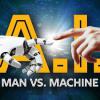
Breaking News
 Government shutdown triggers travel nightmare as controller shortages force ground stops...
Government shutdown triggers travel nightmare as controller shortages force ground stops...
 How a natural PEPTIDE helped me REGENERATE injured tissue
How a natural PEPTIDE helped me REGENERATE injured tissue
 Asteroid Threat Detection and Planetary Defense Can Be Complete and Ready by 2035
Asteroid Threat Detection and Planetary Defense Can Be Complete and Ready by 2035
Top Tech News
 Graphene Dream Becomes a Reality as Miracle Material Enters Production for Better Chips, Batteries
Graphene Dream Becomes a Reality as Miracle Material Enters Production for Better Chips, Batteries
 Virtual Fencing May Allow Thousands More Cattle to Be Ranched on Land Rather Than in Barns
Virtual Fencing May Allow Thousands More Cattle to Be Ranched on Land Rather Than in Barns
 Prominent Personalities Sign Letter Seeking Ban On 'Development Of Superintelligence'
Prominent Personalities Sign Letter Seeking Ban On 'Development Of Superintelligence'
 Why 'Mirror Life' Is Causing Some Genetic Scientists To Freak Out
Why 'Mirror Life' Is Causing Some Genetic Scientists To Freak Out
 Retina e-paper promises screens 'visually indistinguishable from reality'
Retina e-paper promises screens 'visually indistinguishable from reality'
 Scientists baffled as interstellar visitor appears to reverse thrust before vanishing behind the sun
Scientists baffled as interstellar visitor appears to reverse thrust before vanishing behind the sun
 Future of Satellite of Direct to Cellphone
Future of Satellite of Direct to Cellphone
 Amazon goes nuclear with new modular reactor plant
Amazon goes nuclear with new modular reactor plant
 China Is Making 800-Mile EV Batteries. Here's Why America Can't Have Them
China Is Making 800-Mile EV Batteries. Here's Why America Can't Have Them
Where does our 'brain waste' go? Scientists think they've figured it out and can use it.

Scientists are beginning to understand how the brain flushes out waste products in order to stay healthy and fend off neurological diseases.
Two teams of scientists from Washington have uncovered signs that a slow wave of electricity that pulses through the brain during sleep pushes waste products, including the protein closely associated with Alzheimer's disease, from deep in the brain to its surface.
A vein passing through the brain then acts as a pipe to carry waste products out through the barrier that separates the brain and the rest of the body. This deposits them into the bloodstream to be filtered out by the kidneys.
But if the disposal system stops working correctly, which can occur with aging, in cases of traumatic brain injury, and chronic stress, those waste products can accumulate in the brain.
It may also allow immune cells to penetrate the organ, leading to inflammation linked to degenerative brain disorders.
The study was conducted in mice, but researchers believe their findings match up with research on potential causes of Alzheimer's disease and other dementias.
In February, scientists led by Dr Jonathan Kipnis, a neurologist at Washington University in St Louis, answered the question of how the brain gets waste out through the rigid protective barrier without using the body's lymphatic system, a network that drains fluids throughout the body.
The brain is not part of that system and its waste disposal pathway is known as the glymphatic system. It clears out waste generated by energy-consuming metabolic processes - all the chemical processes continuously working in the body to ensure it functions correctly - such as carbon dioxide, damaged proteins and dead cells.
Scientists uncovered exit points around the brain from which cerebrospinal fluid, which carries waste, flowed out to the thick membrane surrounding the brain and spinal cord and into the bloodstream, where the body's lymphatic vessels took over to clear it out.

 No Vacation For You!
No Vacation For You! China Innovates: Transforming Sand into Paper
China Innovates: Transforming Sand into Paper

